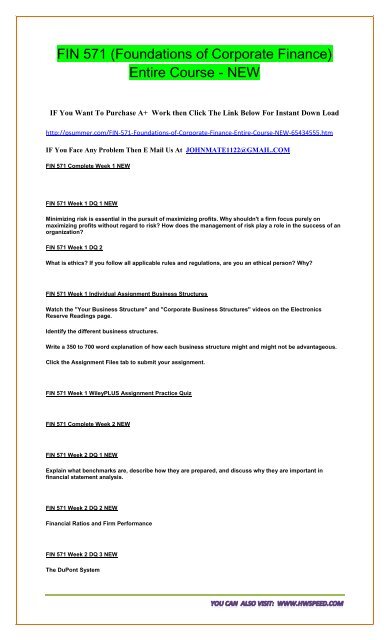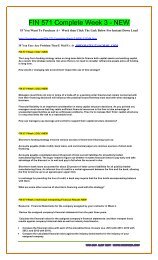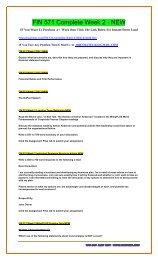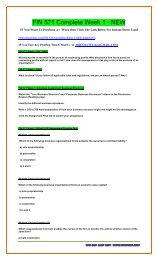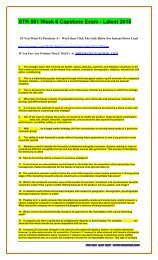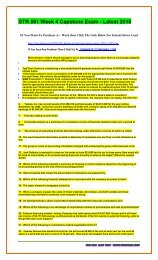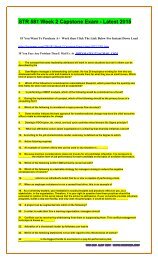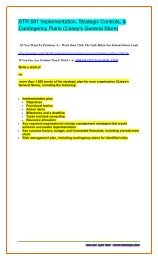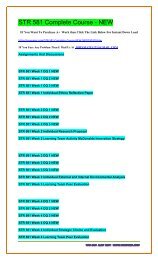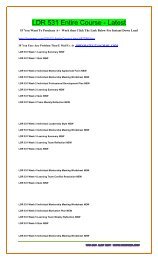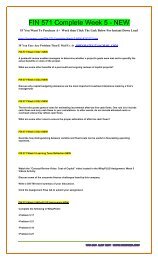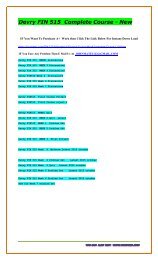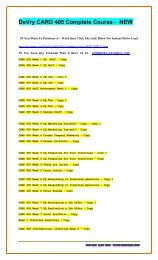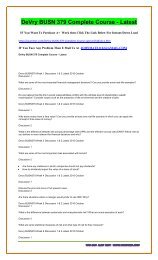FIN 571 (Foundations of Corporate Finance) Entire Course - NEW
FIN 571 (Foundations of Corporate Finance) Entire Course - NEW IF You Want To Purchase A+ Work then Click The Link Below For Instant Down Load http://psummer.com/FIN-571-Foundations-of-Corporate-Finance-Entire-Course-NEW-65434555.htm IF You Face Any Problem Then E Mail Us At JOHNMATE1122@GMAIL.COM
FIN 571 (Foundations of Corporate Finance) Entire Course - NEW IF You Want To Purchase A+ Work then Click The Link Below For Instant Down Load http://psummer.com/FIN-571-Foundations-of-Corporate-Finance-Entire-Course-NEW-65434555.htm IF You Face Any Problem Then E Mail Us At JOHNMATE1122@GMAIL.COM
Create successful ePaper yourself
Turn your PDF publications into a flip-book with our unique Google optimized e-Paper software.
<strong>FIN</strong> <strong>571</strong> (<strong>Foundations</strong> <strong>of</strong> <strong>Corporate</strong> <strong>Finance</strong>)<br />
<strong>Entire</strong> <strong>Course</strong> - <strong>NEW</strong><br />
IF You Want To Purchase A+ Work then Click The Link Below For Instant Down Load<br />
http://psummer.com/<strong>FIN</strong>-<strong>571</strong>-<strong>Foundations</strong>-<strong>of</strong>-<strong>Corporate</strong>-<strong>Finance</strong>-<strong>Entire</strong>-<strong>Course</strong>-<strong>NEW</strong>-65434555.htm<br />
IF You Face Any Problem Then E Mail Us At JOHNMATE1122@GMAIL.COM<br />
<strong>FIN</strong> <strong>571</strong> Complete Week 1 <strong>NEW</strong><br />
<strong>FIN</strong> <strong>571</strong> Week 1 DQ 1 <strong>NEW</strong><br />
Minimizing risk is essential in the pursuit <strong>of</strong> maximizing pr<strong>of</strong>its. Why shouldn't a firm focus purely on<br />
maximizing pr<strong>of</strong>its without regard to risk? How does the management <strong>of</strong> risk play a role in the success <strong>of</strong> an<br />
organization?<br />
<strong>FIN</strong> <strong>571</strong> Week 1 DQ 2<br />
What is ethics? If you follow all applicable rules and regulations, are you an ethical person? Why?<br />
<strong>FIN</strong> <strong>571</strong> Week 1 Individual Assignment Business Structures<br />
Watch the "Your Business Structure" and "<strong>Corporate</strong> Business Structures" videos on the Electronics<br />
Reserve Readings page.<br />
Identify the different business structures.<br />
Write a 350 to 700 word explanation <strong>of</strong> how each business structure might and might not be advantageous.<br />
Click the Assignment Files tab to submit your assignment.<br />
<strong>FIN</strong> <strong>571</strong> Week 1 WileyPLUS Assignment Practice Quiz<br />
<strong>FIN</strong> <strong>571</strong> Complete Week 2 <strong>NEW</strong><br />
<strong>FIN</strong> <strong>571</strong> Week 2 DQ 1 <strong>NEW</strong><br />
Explain what benchmarks are, describe how they are prepared, and discuss why they are important in<br />
financial statement analysis.<br />
<strong>FIN</strong> <strong>571</strong> Week 2 DQ 2 <strong>NEW</strong><br />
Financial Ratios and Firm Performance<br />
<strong>FIN</strong> <strong>571</strong> Week 2 DQ 3 <strong>NEW</strong><br />
The DuPont System
<strong>FIN</strong> <strong>571</strong> Week 2 Learning Team Reflection <strong>NEW</strong><br />
Read the Ethics case, "A Sad Tale: The Demise <strong>of</strong> Arthur Anderson" located in the WileyPLUS Week<br />
Fundamentals <strong>of</strong> <strong>Corporate</strong> <strong>Finance</strong> Chapter readings.<br />
Discuss the mistakes made by Arthur Anderson and potential actions that leadership could have taken to<br />
prevent the organizational failure.<br />
Write a 350- to 700-word summary <strong>of</strong> your discussion.<br />
Click the Assignment Files tab to submit your assignment.<br />
<strong>FIN</strong> <strong>571</strong> Week 2 Individual Business Structure Advice <strong>NEW</strong><br />
Write a 350 to 700 word response to the following e-mail:<br />
Dear Consultant,<br />
I am currently starting a business and developing my business plan. I'm in need <strong>of</strong> some advice on how to<br />
start forming my business. I am not sure exactly how it will be financed and whether or not I want to take on<br />
partners. I am interested and willing to learn the intricacies <strong>of</strong> my options to determine how to best proceed<br />
with my plan.<br />
Please advise on what my options are, the advantages and disadvantages <strong>of</strong> each, and possible tax<br />
consequences for each scenario?<br />
Respectfully,<br />
John Owner<br />
Click the Assignment Files tab to submit your assignment.<br />
<strong>FIN</strong> <strong>571</strong> Week 2 WileyPLUS Practice Quiz <strong>NEW</strong><br />
<strong>FIN</strong> <strong>571</strong> Complete Week 3 <strong>NEW</strong><br />
<strong>FIN</strong> <strong>571</strong> Week 3 DQ 1 <strong>NEW</strong><br />
The Long-Term funding strategy relies on long-term debt to finance both capital assets and working capital.<br />
As a result, this strategy reduces risk since there is no need to consider refinancing assets since all funding<br />
is long term.<br />
How would a 'changing rate environment' impact the use <strong>of</strong> this strategy?<br />
<strong>FIN</strong> <strong>571</strong> Week 3 DQ 2 <strong>NEW</strong><br />
Managers must think not only in terms <strong>of</strong> a trade-<strong>of</strong>f or a pecking order theories but remain concerned with<br />
how their financing decisions will influence the practical issues that they must deal with when managing a<br />
business.<br />
Financial flexibility is an important consideration in many capital structure decisions. As you pointed out,<br />
managers must ensure that they retain sufficient financial resources in the firm to take advantage <strong>of</strong><br />
unexpected opportunities as well as unforeseen problems. They try to manage their firms' capital structures<br />
in a way that limits the risk to a reasonable level.<br />
How can managers use leverage and control to support their capital structure decisions?<br />
<strong>FIN</strong> <strong>571</strong> Week 3 DQ 3 <strong>NEW</strong><br />
Short term funding strategy involves various sources <strong>of</strong> short-term financing such as:
Accounts payable (trade credit), bank loans, and commercial paper are common sources <strong>of</strong> short-term<br />
financing.<br />
Accounts payable constituted about 35 percent <strong>of</strong> total current liabilities for all publicly traded<br />
manufacturing firms. The buyer needs to figure out whether it makes financial sense to pay early and take<br />
advantage <strong>of</strong> the discount or to wait and pay in full when the account is due.<br />
Short-term bank loans accounted for about 20 percent <strong>of</strong> total current liabilities for all publicly traded<br />
manufacturing firms. An informal line <strong>of</strong> credit is a verbal agreement between the firm and the bank, allowing<br />
the firm to borrow up to an agreed-upon upper limit.<br />
In exchange for providing the line <strong>of</strong> credit, a bank may require that the firm holds acompensating balance<br />
with them.<br />
What are some other sources <strong>of</strong> short-term financing used with this strategy?<br />
<strong>FIN</strong> <strong>571</strong> Week 3 Individual Interpreting Financial Results <strong>NEW</strong><br />
Resource: Financial Statements for the company assigned by your instructor in Week 2.<br />
Review the assigned company's financial statements from the past three years.<br />
Calculate the financial ratios for the assigned company's financial statements, and then interpret those<br />
results against company historical data as well as industry benchmarks:<br />
<br />
<br />
Compare the financial ratios with each <strong>of</strong> the preceding three (3) years (e.g. 2014 with 2013; 2013 with<br />
2012; and 2012 with 2011).<br />
Compare the calculated financial ratios against the industry benchmarks for the industry <strong>of</strong> your<br />
assigned company.<br />
Write a 500 to 750 word summary <strong>of</strong> your analysis.<br />
Show financial calculations where appropriate.<br />
Click the Assignment Files tab to submit your assignment.<br />
<strong>FIN</strong> <strong>571</strong> Week 3 Learning Team Reflection <strong>NEW</strong><br />
Watch the "Concept Review Video: Working Capital Management" video located in theWileyPLUS<br />
Assignment: Week 3 Videos Activity.<br />
Discuss strategies these business owners used to manage their working capital.<br />
Write a 350-700 word summary <strong>of</strong> your discussion.<br />
Click the Assignment Files tab to submit your assignment.<br />
<strong>FIN</strong> <strong>571</strong> Week 3 WileyPLUS Practice Quiz <strong>NEW</strong><br />
<strong>FIN</strong> <strong>571</strong> Complete Week 4 <strong>NEW</strong><br />
<strong>FIN</strong> <strong>571</strong> Week 4 DQ 1 <strong>NEW</strong><br />
We can determine the value <strong>of</strong> an investment at the end <strong>of</strong> one period (whether it is a month, quarter or year)<br />
if we know the interest rate to be earned by the investment. If you invest for one period (single period<br />
investment) at an interest rate <strong>of</strong> i, your investment, or principal, will grow by (1 + i) per dollar invested. The<br />
term (1+ i) is the future value interest factor--<strong>of</strong>ten called simply the future value factor.<br />
How can we determine the value <strong>of</strong> a two period investment what components are included in the<br />
calculation?
<strong>FIN</strong> <strong>571</strong> Week 4 DQ 2 <strong>NEW</strong><br />
Explain what the time value <strong>of</strong> money is and why it is important in the field <strong>of</strong> finance.<br />
<strong>FIN</strong> <strong>571</strong> Week 4 Individual Analyzing Pro Forma Statements <strong>NEW</strong><br />
Decide upon an initiative you want to implement that would increase sales over the next five years, (for<br />
example, market another product, corporate expansion, and so on).<br />
Using the sample financial statements, create pro forma statements <strong>of</strong> five year projections that are clear,<br />
concise, and easy to read. Be sure to double check the calculations in your pro forma statements. Make<br />
assumptions that support each line item increase or decrease for your forecasted statements.<br />
Discuss and interpret the financials in relation to the initiative. Make recommendations on potential<br />
discretionary financing needs.<br />
Write a 350 - 700 word analysis <strong>of</strong> the company's short term and long term financing needs and determine<br />
strategies for the company to manage working capital.<br />
Click the Assignment Files tab to submit your assignment.<br />
<strong>FIN</strong> <strong>571</strong> Week 4 Learning Team Reflection <strong>NEW</strong><br />
Watch the "Concept Review Video: Stock Valuation" video located in the WileyPLUS Assignment: Week 4<br />
Videos Activity.<br />
Discuss how markets and investors value a stock.<br />
Write a 350-700 word summary <strong>of</strong> your discussion.<br />
Click the Assignment Files tab to submit your assignment.<br />
<strong>FIN</strong> <strong>571</strong> Week 4 WileyPLUS Practice Quiz <strong>NEW</strong><br />
<strong>FIN</strong> <strong>571</strong> Complete Week 5 <strong>NEW</strong><br />
<strong>FIN</strong> <strong>571</strong> Week 5 DQ 1 <strong>NEW</strong><br />
A postaudit review enables managers to determine whether a project's goals were met and to quantify the<br />
actual benefits or costs <strong>of</strong> the project.<br />
What are some other benefits <strong>of</strong> a post audit and ongoing reviews <strong>of</strong> capital projects?<br />
<strong>FIN</strong> <strong>571</strong> Week 5 DQ 2 <strong>NEW</strong><br />
Discuss why capital budgeting decisions are the most important investment decisions made by a firm's<br />
management.<br />
<strong>FIN</strong> <strong>571</strong> Week 5 DQ 3 <strong>NEW</strong><br />
The text discusses general rules for estimating incremental after-tax free cash flows. One rule is to include<br />
cash flows and only cash flows in your calculations. In other words, do not include allocated costs or<br />
overhead unless they reflect cash flows.<br />
What are some other rules to ensure the proper estimation <strong>of</strong> after-tax cash flows?
<strong>FIN</strong> <strong>571</strong> Week 5 DQ 4 <strong>NEW</strong><br />
Describe how distinguishing between variable and fixed costs can be useful in forecasting operating<br />
expenses.<br />
<strong>FIN</strong> <strong>571</strong> Week 5 Learning Team Reflection <strong>NEW</strong><br />
Watch the "Concept Review Video: Cost <strong>of</strong> Capital" video located in the WileyPLUS Assignment: Week 5<br />
Videos Activity.<br />
Discuss some <strong>of</strong> the corporate finance challenges faced by this company.<br />
Write a 350-700 word summary <strong>of</strong> your discussion.<br />
Click the Assignment Files tab to submit your assignment.<br />
<strong>FIN</strong> <strong>571</strong> Week 5 WileyPLUS Assignment <strong>NEW</strong><br />
<strong>FIN</strong> <strong>571</strong> Week 6 DQ 1 <strong>NEW</strong><br />
<strong>FIN</strong> <strong>571</strong> Week 6 DQ 2 <strong>NEW</strong><br />
<strong>FIN</strong> <strong>571</strong> Week 6 Learning Team Reflection <strong>NEW</strong><br />
<strong>FIN</strong> <strong>571</strong> Week 6 Learning Team Reflection <strong>NEW</strong><br />
<strong>FIN</strong> <strong>571</strong> Week 6 WileyPLUS Assignment <strong>NEW</strong><br />
<strong>FIN</strong> <strong>571</strong> Week 6 WileyPLUS Practice Quiz <strong>NEW</strong><br />
<strong>FIN</strong> <strong>571</strong> <strong>FIN</strong>AL EXAM - <strong>NEW</strong>


